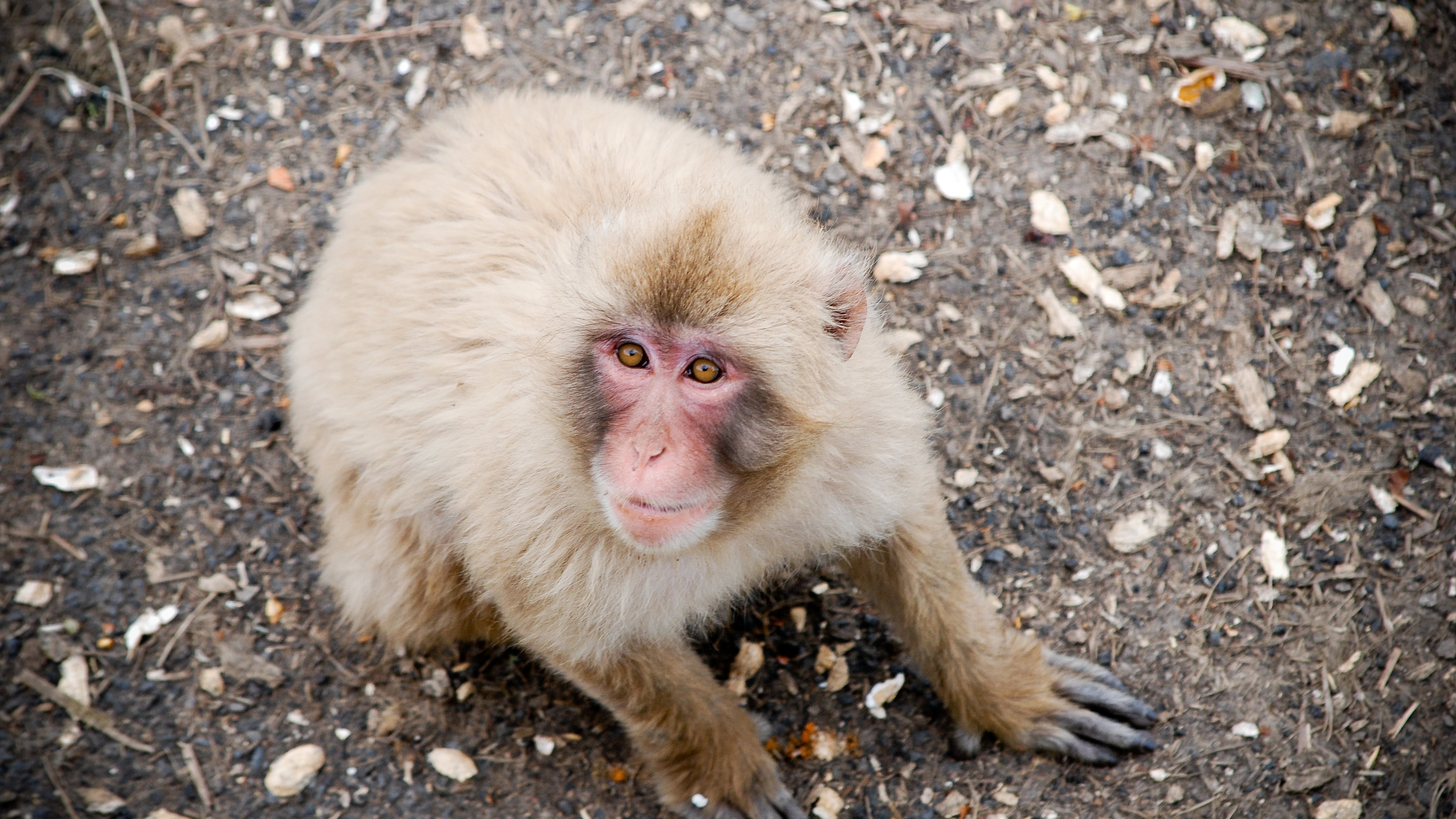In the mid-1960s, a troop of Japanese macaques were rampaging around Mihara, a town just east of Hiroshima, eating crops and pissing off local farmers.
The authorities took drastic action in 1964. They rounded up the macaques and deported 55 of them across the Pacific Ocean to Hillsboro. Why there? Because the National Institutes of Health had just built what’s now known as the Oregon National Primate Research Center, the first of eight facilities set up to breed nonhuman primates for medical research.
After an “initial period of savage fighting and chasing,” the expat macaques fared well in Hillsboro, which has a climate similar to Mihara’s, according to a 1967 research paper on the troop. Many of Oregon’s macaques live in postmodern outdoor runs with walls of curving concrete designed by Skidmore, Owings & Merrill, the same architecture firm that designed Big Pink. Soon, baby macaques arrived.
The descendants of that original troop still live in Hillsboro, under the care of Oregon Health & Science University, which took over the ONPRC in 1998. Animal rights activists have been trying to shut down the center for decades, and they’ve amped up their efforts this year, running ads on radio and television and bombarding elected officials with email, hoping to use OHSU’s since-canceled purchase of Legacy Health as a catalyst.
Research at the center is outdated and cruel, critics say. Many experiments could be done on human organs grown in a lab, or with computer models. Too much of the research being done in Hillsboro is make-work for monkeys that seeks to clear up questions long since asked and answered in humans, they say, like whether smoking cannabis during pregnancy affects a fetus.
In many ways, animal rights groups say, the Japanese macaque troop in Hillsboro most clearly illustrates the folly of the seven remaining national primate centers (Harvard closed its center in 2015). Most researchers prefer rhesus macaques, a species from South Asia, because they are more plentiful and much more is known about them. Japanese macaques aren’t in demand, but OHSU keeps its colony going. They numbered 446 as of Sept. 30, according to state records. Most of them—332—lived in a breeding colony, producing 44 offspring in the year to that date.
Greg Westergaard, founder of Alpha Genesis, a commercial primate-breeding operation in South Carolina, says he doesn’t understand why OHSU keeps breeding Japanese macaques. In Japan, they draw tourists by reclining in the hot springs near Nagano, where they bear the name “snow monkeys.” But for research, they are a little too offbeat.
“If I had Japanese macaques here, no one would ever ask me for them,” Westergaard says. “You’re not going to find researchers who want to use them.”
Whether the increasingly lonely experiments OHSU performs on Japanese macaques are necessary is a matter of some debate. Westergaard suspects that OHSU conducts the experiments to justify keeping the macaques around. Animal rights advocates agree.
“As taxpayers, we pay for the upkeep of these monkeys,” says Lisa Jones-Engel, who did primate research in the lab and the wild for three decades before becoming senior science adviser for primate experimentation at People for the Ethical Treatment of Animals in 2019. “ONPRC can’t afford idle monkeys. Even those not involved in a study are absorbed into schemes to justify their chow. It’s not about relevant science. It’s about keeping the money flowing.”
OHSU says primate research is crucial to finding new cures for humans. In the university’s telling, the Japanese macaques are uniquely valuable. Over 60 years, the colony has developed “spontaneous diseases” similar to human illnesses, including macular degeneration, multiple sclerosis, and Batten disease, an incurable condition that causes seizures and blindness in children.
None of the diseases has been cured, but OHSU is hard at work on them, spokesman Erik Robinson says. Only primates have macula, the thin, light-gathering structure in the back of the eye, so primates are the only nonhuman subjects that can be used for study. Researchers are testing two promising therapies on Japanese macaques now, Robinson says.
The same is true for MS, he says, where researchers are looking for ways to repair damage done as a faulty immune system attacks the protective myelin sheath around nerve cells, disrupting neural signals that guide sensation and movement. On Batten disease, researchers aim to develop a gene therapy that can help humans and monkeys alike.
PETA’s Jones-Engel is skeptical. Japanese macaques and humans had a common ancestor 24 million years ago, and their paths have diverged since then, she says.
Monkeys developing conditions that look like multiple sclerosis, Batten disease, or macular degeneration doesn’t mean they have the same molecular pathways, immune responses, or therapeutic targets as humans. And better research is being done in humans, she says.
“Spending decades, and millions, on a tiny number of monkeys with vaguely ‘MS-like’ symptoms is not progress,” Jones-Engel says. “It’s scientific inertia.”
Most of the ONPRC’s $63 million operating budget comes from the NIH, and researchers have to hustle for that cash through individual grants. A search of NIH funding shows that scientists have spent at least $4.7 million in government money researching Japanese macaques since 1985.
In the earliest study in the NIH database, researchers implanted testosterone packets in pregnant Japanese macaques to see how it would affect their offspring. Because of an “unplanned procedural change” by the surgeon, researchers ended up with a high-dose group and a low-dose group, according to a paper describing the study. The results: High-dose females mounted other macaques more often (Japanese macaques are bisexual) and low-dose females mounted juvenile macaques more than normal macaques did. Price: $137,259.
Most recently, researcher Betsy Ferguson got $446,136 from NIH to map the genome of Japanese macaques at the ONPRC to learn more about the genetic origins of macular degeneration, Batten disease and MS over the past 60 years.
Like the animal rights groups, the Trump administration doesn’t see much value in animal studies like these. It has directed both the Food and Drug Administration and the NIH to scale back animal testing, and it has proposed cutting the NIH’s overall budget roughly in half to $27 billion. OHSU gets about $300 million in NIH funds each year.
Critics, including Neal Barnard, president of the Physicians Committee for Responsible Medicine, say OHSU will be stuck with a worthless, stranded asset as animal research fades, and the academic medical center should cut its losses and direct its assets toward patient care.
But that would be complicated. OHSU can’t send 5,000 primates to the Humane Society. Liz Tyson, director of animal welfare and advocacy at Born Free USA, which runs a primate sanctuary near San Antonio, Texas, says it costs $3,500 a year to keep one monkey alive in captivity. The Born Free sanctuary recently put together an estimate of what it would cost to take 300 macaques from Charles River Laboratories that allegedly had been imported illegally from Cambodia. Macaques live about 30 years, Tyson says. The total for 300 monkeys at 30 years: $20 million.
OHSU director of research Peter Barr-Gillespie has said it would cost more to close the primate center than to keep it open for another year or two: about $100 million.
Figures like that spell doom for captive monkeys, which can’t be reintroduced to the wild because they often have diseases that come with domestication.
“What they will most likely do is kill the animals,” Tyson says. “There’s no infrastructure that allows for these animals to be rescued.”
No infrastructure except sanctuaries like hers, which couldn’t take 5,000 monkeys. It would struggle to take OHSU’s 446 Japanese macaques. Born Free houses 210 primates, many of them refugees from labs and private pet owners.
Ironically, about 100 are descendants of a troop of Japanese macaques sent from Japan. They lived in the Arashiyama Bamboo Forest near Kyoto, and their numbers grew as primatologists used food to draw them in for research. The troop divided, and one half moved into Kyoto’s suburbs, irking local residents. An American animal lover paid to move them to an uncle’s ranch in Texas in 1972, seven years after the first group of macaques landed in Hillsboro.

